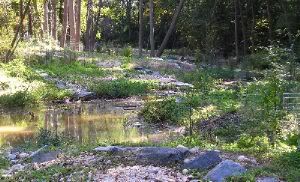Cleaning Up Our Arteries
This weekend's Washington Post Magazine had a great piece on the efforts of locals citizens to clean up metro area streams. It begins with the account of a golf course whose herbicides poisoned Donaldson Run in Arlington, VA and explains the growth of stream protection efforts over the course of the past decade.
It also discusses, at some length, the increasing problem of impervious surface ("The Chesapeake Bay watershed has enough pavement to park 116 million cars.") and the need to effectively treat stormwater runoff.
One paved acre of land throws off 16 times more water than a one-acre meadow does. Once the impervious rating in a watershed climbs much over 10 to 15 percent, the stream that drains it begins to wash away. When the impervious rating is 55 percent, the variety of stream creatures drops by 90 percent, and sensitive species disappear entirely.
Locally, we've been lucky to have several such restoration projects in the last few years, including one in front of Edgewater Elementary, Howard's Branch in Severna Park, and Wilelinor in Annapolis. The Wilelinor project, the most recently completed of the three, transformed several failing stormwater ponds that had been seeping silt into Church Creek, into one of the most extraordinary feats of engineering I've had the pleasure to witness.
From Route 2 to Church Creek now flows a sinuous, vegetated stream, flanked by several infiltration ponds. Thanks to the efforts of local volunteers, its banks have been planted with native vegetation and shrubs, and Atlantic White Cedars climbing skyward toward the holes in the canopy.

Wilelinor's beautiful new stream
The National River Restoration Science Synthesis Project is working to develop a tool to measure the ultimate effectiveness of such projects.
Labels: Restoration

0 Comments:
Post a Comment
<< Home